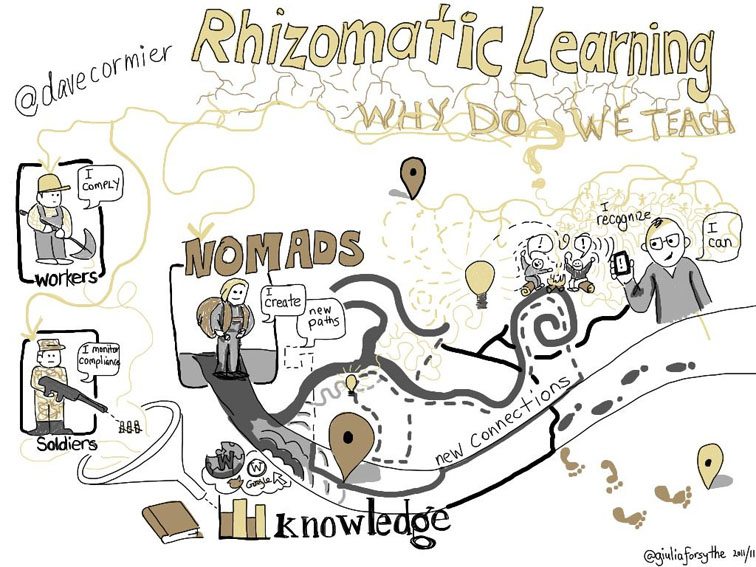Rhizomatic Learning Is A Metaphor For How We Learn
by Terry Heick
If we’re matching the learning theories and instructional strategies with existing social conditions, we’ve really got some work to do.
Existing theories, including Connectivism, Constructivism, Communal Constructivism, and the above idea of rhizomatic learning, freely allude to both the potency and inherent chaos of crowds. Direct instruction depends on the credibility of both teacher and curriculum from the perspective of the learner, and, more optimistically, on the homogeneous schema of learners across a classroom.
Rhizomatic learning is not interested in your data-driven instructional strategy you’re hoping to use in the operation of an outcomes-based and backward-designed learning system.
After all, you–or someone before you–has parsed the universe itself into but a handful of “content areas,” listed exactly what students should come to know, and then placed 30 students by age and geographic location and asked that you lead them all to “proficiency” of each standard, no matter their background, will to learn, unique interests, or, more critically, existing schema.
And the key to making all of this magic happen? Pre-assessment and resultant data to constantly monitor and revise planned instruction. Data doesn’t lie.
That’s pretty ambitious.
Rhizomatic learning takes another approach.
It freely admits the beautiful complexity of the human experience, and thus, by proximity, the sheer craziness of the learning process. This idea, not so much a learning theory as it is a clever and accurate metaphor, describes learning as having no beginning nor an end. It posits that learners have needs so diverse that the “teacher” is essentially off the hook in meeting every need for every student, no matter how noble that sounds.
One person as the arbitrator between 30+ students and the Common Core or equivalent academic standards is a bit nutty. Dave Cormier’s post, which explains this idea more skillfully than I have here, explains that our challenge is “to acknowledge that learners come from different contexts, that they need different things, and that presuming you know what those things are is like believing in magic.”
So by starting off a lesson or unit by anticipating–and betting your professional career–on what students will come to understand is a problem. Within the rhizomatic perspective, “knowledge can only be negotiated, [and is] a personal knowledge-creation process with mutable goals and constantly negotiated premises.”
So, iteration.
Design. Try. Monitor. Fail. Reflect. Rethink. Redesign. Reiterate.
Iteration, in a project-based learning process, for example, isn’t always flattering but is rather the socializing of how it is we come to know things.
In that way, rhizomatic learning is a metaphor for how we learn.
The Presentation
In addition to @davecormier‘s ideas (and @guiliaforsythe’s supplementary visual), Steven Wheeler’s presentation from 2013 reviews related ideas contextualizing the modern learning climate. The gist? Rapid technology change has produced critical new pathways for both formal and informal learning.

